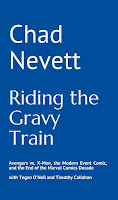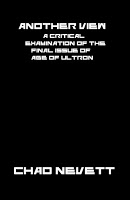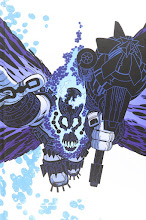[This is the first in a series of posts examing Joe Casey's run on Deathlok issue-by-issue. New posts Tuesdays, Thursdays and Saturdays.]
Deathlok was launched along with Warlock (the X-related robot, not Adam Warlock) and X-51 (Machine Man) as part of the M-Tech line. Wait, you don't remember M-Tech? Where were you in 1999?
Okay, so the line was kind of meh and didn't last long. But, it featured Deathlok by Joe Casey and Leonardo Manco, a real mindfuck of a comic and precursor to stuff like Automatic Kafka--Ashley Wood was Casey's first choice for art, but Wood had a better offer drawing Spawn stuff. The series itself was a spin-off from Casey's Cable and Incredible Hulk runs (of which I've only read the former)--and of the weird X-Men crossover involving the Red Skull, SHIELD and robots or something, I dunno, who cares, shut up.
This Deathlok series is unique in that it uses the name "Deathlok," but has no ties to any other incarnations of the character. Hell, the name is barely used in the comic itself (if ever--the robot itself is referred to as the LOK unit or something similar). This seemed to annoy fans of Deathlok, but we don't care about them, do we.
The first issue (actually, the first arc) of this series is some of Casey's best work formally as he weaves various threads together using some interesting tricks. In a Wizard article back around this time, they were discussing the future of comics and who was the next *insert person*. They called Warren Ellis the next Alan Moore and... well, I can't remember anything else from it except that Joe Casey was called the next Kurt Busiek. At this time, he hadn't done much work except Cable, Hulk and Deathlok for Marvel. Wizard noted Casey's habit of taking old Marvel concepts and updating them for new stories, calling him a continuity buff much like Busiek. (At the time, it fit rather well, but I'd now call Casey the next Grant Morrison--if you're going to call him the next anyone that is--and, yeah, most of you think I'm crazy for saying that.)In these articles, though, the more established person commented on the up-and-comer (so, Moore told us why Ellis is great) and Busiek gushed over the first issue of Deathlok, calling it the most confident debut of a comic he'd read in a long time (or something like that). And he's absolutely right.
The issue deals with two stories and three narrative perspectives. In the first, SHIELD's air cavalry is tracking a rampaging robot in Las Vegas, narrated by the commanding officer of the air cav, Larry Young. However, a second narrative perspective (of sorts) is added when the robot shows up: definitions from the dictionary. In three panels, taking up two pages, we get the definitions of: presentiment, incongruous, disquietude, automaton, confront and panic. It stopped me in my tracks when I read this issue when it first came out, because it was so strange to see something like this done in a Marvel book. The definitions work to comment on what's taking place, but also suggest that this robot only relates to the world through such basic ideas.
In the second, we're dealing with some little kid who's experiencing headaches and weird memory flashbacks. Over the course of the issue, we discover that this kid has the mind of SHIELD Agent Jack Truman in his head--we last saw Truman in Cable where he was tasked with taking down Cable, but was horrifically injured. We don't know how he got to be in the body of a little kid, but we do know it's related to the mindless LOK robot rampaging through Vegas.
The issue itself is rather dense in that a lot of information is given. We have an entire feud of sorts between Young and Nick Fury over an event from the previously mentioned Cable story, various bits concering other air cav members, numerous scenes of Billy (the little kid) displaying elements of Truman (including one scene where he beats the shit out of a bunch of kids at recess), the fight between air cav and the LOK prototype, and some stuff with Fury alone. Not the typical way to start a series as we have no idea where it's going. The real main character of the book, Jack Truman doesn't show up until the last page where he completely takes over Billy's body--in a scene at school where Casey interupts Billy's narration with two definitions, a technique associated with the LOK robot.
Manco's art is a nice fit and you can see why Wood would have also worked nicely. Manco is a much clearer artist than Wood, but still maintains a dark, sketchy, not-quite-right style similar to Wood's. This is a book of unstability, physically and mentally, and the art reflects that. He also has no problem cramming a lot into each page without it seeming crowded or hard to make out.
In this issue, Casey sets up (almost) the entire series, especially the themes of mental instability, what it means to be human, conflicts with authority and issues of family.
skip to main |
skip to sidebar
"Chad Nevett is the spicy mustard of comics reviews" -- Adam Langton, Lovable Fucker and Chad Nevett's Best Man
About
GraphiContent was a blog featuring comic criticism, commentary, analysis, theory and discussion. Oh, and the odd rant, review or totally random post.
Chad Nevett has a BA in English and political science, and an MA in English Language & Literature--Creative Writing. He was a reviewer for Comic Book Resources, blogger for Comics Should be Good, and writer for 411mania. He resides in Windsor, Ontario with his wife and her cat. He can be reached at chevett13[at]yahoo[dot]ca.
Notable Posts (In Chronological Order)
- The Future is X-Rated: Marvel Boy, the Modern World, and the History of the Marvel Universe
- A Music Video on Paper: The Final Chapter of Codeflesh
- Tony Stark, Futurist
- "All you need is fuck."
- Man v. Superman
- Civil War v. Infinite Crisis
- Building a Better Batman: Grant Morrison's First Year on Batman
- U.S. v. T.H.E.M. with Little Ol' Me Stuck in the Middle
- Mark Millar's Ultimate X-Men
- Building a Better Batreader: Grant Morrison's Second Year on Batman
- Secret Invasion Reading Order (Updated June 29, 2013)
- Top 25 Warren Ellis Comics (Oct. 2009)
- Building a Better Batfamily: Grant Morrison's Third Year on Batman (and Robin)
- You Don't Just Want to Break Me, You Want to Tear Me Apart
- 50 Things I Learned in My Three Years and Four Months as a Reviewer for Comic Book Resources
- Avengers vs. X-Men Reading Order (Updated August 17, 2013)
Notable Collections of Posts (In Semi-Chronological Order)
- Joe Casey Comics Archive
- Countdown to Who Cares?
- The Chad and Steve Q&A Series
- I've Got 52 Problems, but a Bitch ain't One
- Best of 2007
- Hello Cosmic: The Works of Jim Starlin Archive
- Chad's Jackass Comic Creator Interviews from 2001
- The Superman 2000 Pitch (with Tim Callahan)
- Raymond Chandler's "Twelve Notes on the Mystery Story"
- Best of 2008
- Blogathon 2009: Brian Michael Bendis's Avengers
- Best of 2009
- Art Discussion Month 2010
- Five Years Blogging: A Life Well Wasted (with David Brothers)
- Booze, Broads & Bullets: Sin City
- Blogathon 2010: Hellblazer (and Hellblazer Posts Beyond the Blogathon)
- Best of 2010
- 28
- Blogathon 2011: Superhero Comics of the Past Decade
- Best of 2011
- Riding the Gravy Train (Avengers vs. X-Men) Archive
- Blogathon 2013: Comics Critics All-Stars
- Best of 2012
Links
Blogs Worth Reading
-
-
The X-Axis – w/c 15 April 202410 hours ago
-
-
-
-
The Mighty Crusaders Number Four #031 month ago
-
The Last Thorsday1 month ago
-
Everybody’s Rockin’6 months ago
-
-
Social (Science) Fiction8 months ago
-
The Rest of the Cruise1 year ago
-
-
-
-
Untitled 1:5 years ago
-
Farewell, sweet prince6 years ago
-
Hello World6 years ago
-
-
-
That’s a wrap.9 years ago
-
episode 026: exit the world10 years ago
-
-
Books Read in 201211 years ago
-
Building Stories - Suggested Reading Order11 years ago
-
Final Crisis #715 years ago
-
Riding the Gravy Train: Avengers vs. X-Men, the Modern Event Comic, and the End of the Marvel Comic
Another View: A Critical Reading of the Final Issue of Age of Ultron
GØDLAND CELESTIAL EDITION THREE
Shot in the Face: A Savage Journey to the Heart of Transmetropolitan
Keeping the World Strange: A Planetary Guide
Minutes to Midnight: Twelve Essays on Watchmen
Writing Without Direction: 10 1/2 Short Stories by Canadian Authors under 30
Blog Archive
-
▼
2007
(252)
-
▼
December
(27)
- Hello Cosmic 18: Infinity Abyss
- The Sunday Open: Astonishing X-Men Hardcover Vol. ...
- Joe Casey Comics: Deathlok #11
- Hello Cosmic Part 17: Warlock & The Infinity Watch...
- Joe Casey Comics: Deathlok #10
- The Sunday Open: Pre-Christmas Books
- Joe Casey Comics: Deathlok #9
- Hello Cosmic Part 16: Warlock & The Infinity Watch...
- Joe Casey Comics: Deathlok #8
- Hello Cosmic Part 15: Blood & Thunder
- Joe Casey Comics: Deathlok #7
- Hello Cosmic Part 14: The Infinity Crusade Part Three
- It's my mom's birthday, so let's celebrate with ne...
- Joe Casey Comics: Deathlok #6
- Hello Cosmic Part 13: The Infinity Crusade Part Two
- Joe Casey Comics: Deathlok #5
- Hello Cosmic Part 12: The Infinity Crusade Part One
- Joe Casey Comics: Deathlok #4
- Hello Cosmic Part 11: Warlock & The Infinity Watch...
- Four books, two of them superhero-related, none fr...
- Joe Casey Comics: Deathlok #3
- Hello Cosmic Part 10: The Infinity War Part Two
- Joe Casey Comics: Deathlok #2
- Hello Cosmic Part 9: The Infinity War Part One
- Joe Casey Comics: Deathlok #1
- Hello Cosmic Part 8: Warlock & The Infinity Watch ...
- conference wrap-up
-
▼
December
(27)






